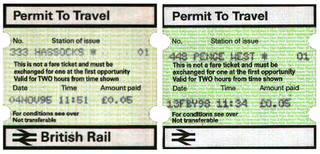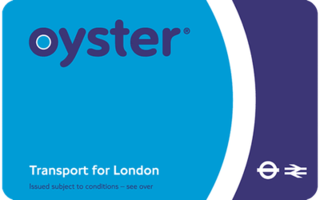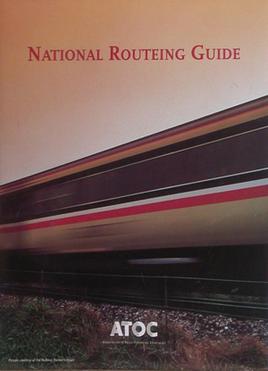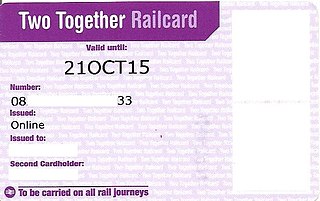Related Research Articles
National Rail (NR) is the trading name licensed for use by the Rail Delivery Group, an unincorporated association whose membership consists of the passenger train operating companies (TOCs) of England, Scotland, and Wales. The TOCs run the passenger services previously provided by the British Railways Board, from 1965 using the brand name British Rail. Northern Ireland, which is bordered by the Republic of Ireland, has a different system. National Rail services share a ticketing structure and inter-availability that generally do not extend to services which were not part of British Rail.

Gatwick Express is an express rail passenger service between London Victoria, Gatwick Airport, and Brighton in South East England. It is the brand name used by the Govia Thameslink Railway train operating company on the Gatwick Express route of the Thameslink, Southern and Great Northern franchise.

In the ticketing system of the British rail network, a Permit to Travel provisionally allows passengers to travel on a train when they have not purchased a ticket in advance and the ticket office of the station they are travelling from is closed, without incurring a penalty fare.

The Oyster card is a payment method for public transport in London in England, United Kingdom. A standard Oyster card is a blue credit-card-sized stored-value contactless smart card. It is promoted by Transport for London (TfL) and can be used on travel modes across London including London Buses, London Underground, the Docklands Light Railway (DLR), London Overground, Tramlink, some river boat services, and most National Rail services within the London fare zones. Since its introduction in June 2003, more than 86 million cards have been used.

The Travelcard is an inter-modal travel ticket for unlimited use on the London Underground, London Overground, Elizabeth line, Docklands Light Railway, London Trams, London Buses and National Rail services in the Greater London area. Travelcards can be purchased for a period of time varying from one day to a year, from Transport for London, National Rail and their agents. Depending on where it is purchased, and the length of validity, a Travelcard is either printed on a paper ticket with a magnetic stripe or encoded onto an Oyster card, Transport for London's contactless electronic smart card, or an ITSO smartcard issued by a National Rail train operating company. The cost of a Travelcard is determined by the area it covers and, for this purpose, London is divided into a number of fare zones. The Travelcard season ticket for unlimited travel on London Buses and the London Underground was launched on 22 May 1983 by London Transport. One Day Travelcards and validity on other transport modes were added from 1984 onwards. The introduction of the Travelcard caused an increase in patronage and reduced the number of tickets that needed to be purchased by passengers.

Morley railway station serves the town of Morley in West Yorkshire, England.
The London Underground and Docklands Light Railway (DLR) metro systems of London, England uses a mix of paper and electronic smart-card ticketing.

Tickets issued from British Rail's APTIS system had a considerable amount of detail, presented in a consistent, standard format. The design for all tickets was created by Colin Goodall. This format has formed the basis for all subsequent ticket issuing systems introduced on the railway network – ticket-office based, self-service and conductor-operated machines alike.

The Network Railcard is a discount card introduced in 1986 by British Rail, upon the creation of their Network SouthEast sector in parts of Southern England.
There is no single 'discount railcard' available on the UK railway network. In addition to the large number and variety of short-term or localised promotional fares that have been available to passengers on the British railway network in recent decades, there are many permanent concessionary fare schemes available to passengers. Some of these take the form of Railcards, which can be purchased by people who qualify according to the conditions, and which give discounts for all journeys over a period; other concessions are available for individual journeys. In all cases, details of the type of concession will be printed on the passenger's travel ticket, to distinguish reduced-rate tickets from those sold at the standard full fare.

Ascom B8050, usually known by the name QuickFare, is an early example of a passenger-operated railway ticket issuing system, consisting of a series of broadly identical machines installed at British railway stations from 1989 onwards. The machines allow passengers to buy the most popular types of ticket themselves, without having to go to a booking office, and are therefore useful at unstaffed, partly staffed or busy stations. All QuickFare machines have been replaced by more modern technology.

The 16–25 Railcard is an annual card giving discounts on certain types of railway ticket in Britain. It is available to anybody aged between 16 and 25 (inclusive), and certain mature students aged 26 and above, and is currently priced at £30.00. There is no restriction on the number of times the Railcard can be used to purchase discounted tickets during the period of its validity, and there are no geographical restrictions on its use.

The National Routeing Guide is a document, the definitive resource on the validity of rail tickets for the purpose of rail travel in Great Britain. As stated by the Rail Regulator, "[it] sets out passengers' rights to use the network flexibly". It is a book produced by the Rail Delivery Group, which is carried by any rail ticket inspector and is also on hand for station staff.
Fare avoidance, as distinct from fare evasion, is the lawful use of knowledge to travel using tickets which cost significantly less than the 'normal' fare for a given journey, which is what one might be expected to use. It is common in some parts of the world with complex travel networks, notably the National Rail network of Great Britain.

The Senior Railcard is an annual card available to people aged 60 and over, which gives discounts on certain types of railway ticket in Britain. The Railcard has existed in various forms since 1975; the current version is priced at £30.00 and is valid for one year, with a 3-year card available for £70. It is one of a wide variety of discounted and concessionary fare schemes available on Britain's railway network.
The Family and Friends Railcard is an annual rail travel discount card for use in Great Britain by adults travelling with at least one child. Cards valid for either one or three years can be purchased at a cost of £30 for one year or £70 for three. It is one of the discounted and concessionary fare schemes available on Britain's railway network to people who either belong to particular groups or who are willing to buy tickets ahead of the date of travel. Before 18 May 2008 it was known as the Family Railcard, but the name was changed to reflect the fact that discounted travel is not restricted to adults and children who are related.

The OV-chipkaart is a contactless smart card and integrated ticketing system used for all public transport in the Netherlands. First introduced in the Rotterdam Metro in April 2005, it has subsequently been rolled out to other areas and travel modes. It fully replaced the national strippenkaart system for buses, trams, and metro trains in 2011, and the paper ticket system for rail travel in July 2014.

Opal is a contactless smartcard fare collection system for public transport services in the greater Sydney area and most other urban areas of New South Wales, Australia. Operation of the Opal system is managed by the New South Wales Government's transport authority, Transport for NSW. First launched in late 2012, Opal is valid on Transport for NSW's metro, train, bus, ferry and light rail services that operate in Sydney and the neighbouring Central Coast, Hunter Region, Blue Mountains, Illawarra and Southern Highlands areas. Opal equipment was designed from the start to support a variety of cards, but launched with the captive Opal cards.
GO Transit is the inter-regional transportation authority of the Golden Horseshoe, which includes the Greater Toronto and Hamilton Area. It is Canada's oldest regional transit system, first serving passengers in 1967.

The Two Together Railcard is a scheme which gives discounts on certain types of railway ticket in Britain. Launched nationally in 2014 after a successful trial in 2011–12, it was the first new Railcard scheme since the 1980s. It is available to any two named individuals aged 16 or over and is priced at £30.00. There is no restriction on the number of times the Railcard can be used to purchase discounted tickets during the period of its validity, and there are no geographical restrictions on its use.
References
- ↑ Hatano, Linda (January 2004). "Complexity versus Choice: UK Rail Fares" (PDF). Japan Railway & Transport Review. No. 37. pp. 26–34. Archived from the original (PDF) on 11 August 2017.
- ↑ Association of Train Operating Companies (24 April 2008). "ATOC Announces Simpler Rail Fares" (Press release). Archived from the original on 11 July 2016.
- ↑ "National Rail Enquiries Off-Peak and Super Off-Peak ticket terms and conditions".
- ↑ "Ticket Barriers retaining tickets". RailUK Forums. Retrieved 6 September 2019.